HSN713 Assignment: Food Nutrition and Behaviour Analysis and Model
VerifiedAdded on 2022/07/28
|15
|4240
|26
Essay
AI Summary
This assignment critically examines the Theory of Planned Behavior (TPB) and its effectiveness in explaining human food choices. It begins by outlining the core concepts of TPB, including its advantages and disadvantages, and then analyzes its limitations in predicting food-related behaviors. The assignment then explores alternative drivers of human food choice, such as family influence, cultural perceptions, convenience, and habits, which are not adequately addressed by the TPB. The paper proposes an alternative Food Choice Model (FCM) and provides a detailed analysis of its strengths and weaknesses, arguing for its potential to offer a more comprehensive understanding of the factors influencing dietary decisions. The discussion also encompasses sensory responses to food, social and economic variables, and mood states, highlighting the complex interplay of factors shaping individual food choices. The assignment concludes by emphasizing the need for a multifaceted approach to understanding and improving dietary habits, incorporating sensory pleasures and socio-economic factors.
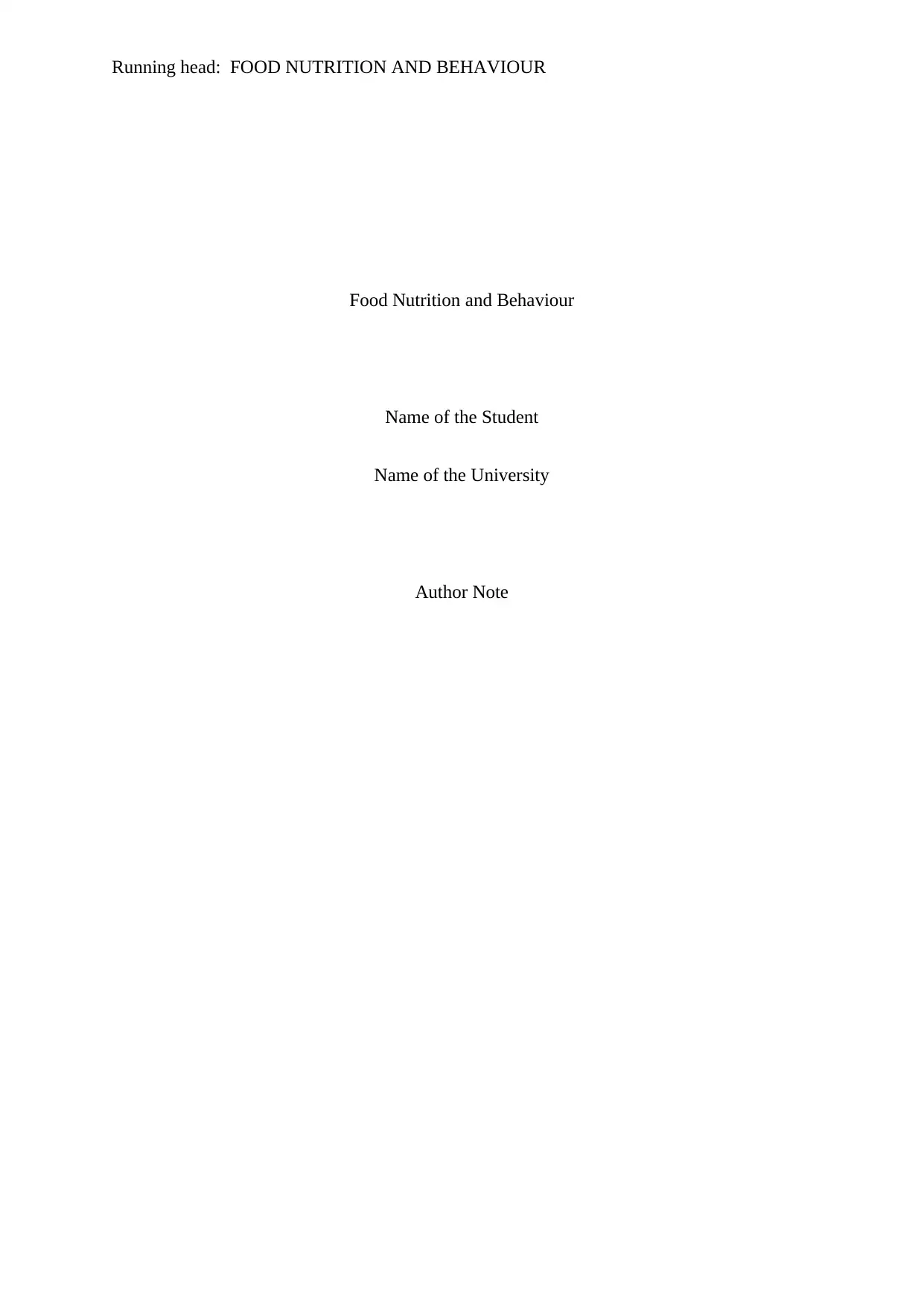
Running head: FOOD NUTRITION AND BEHAVIOUR
Food Nutrition and Behaviour
Name of the Student
Name of the University
Author Note
Food Nutrition and Behaviour
Name of the Student
Name of the University
Author Note
Paraphrase This Document
Need a fresh take? Get an instant paraphrase of this document with our AI Paraphraser
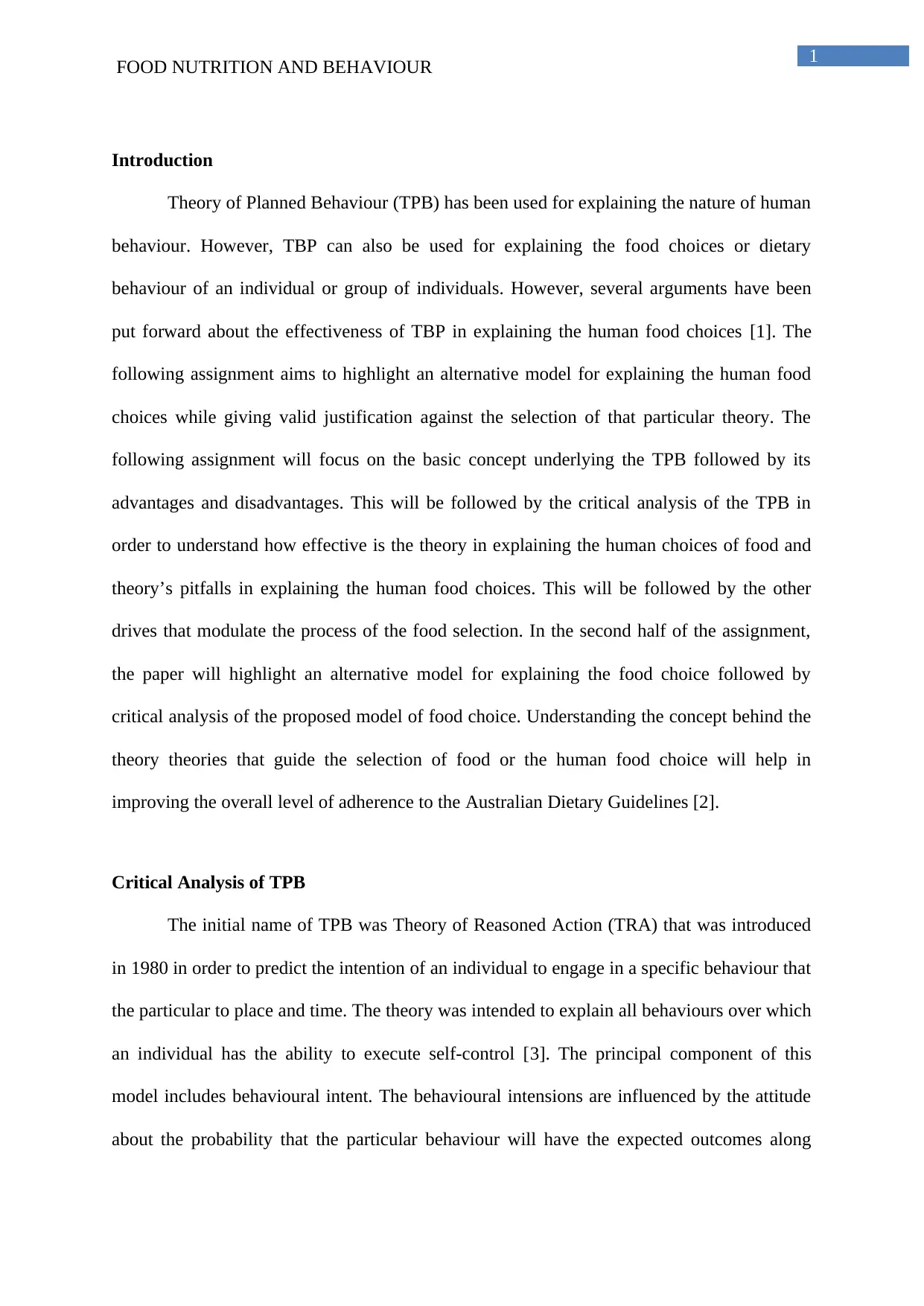
1
FOOD NUTRITION AND BEHAVIOUR
Introduction
Theory of Planned Behaviour (TPB) has been used for explaining the nature of human
behaviour. However, TBP can also be used for explaining the food choices or dietary
behaviour of an individual or group of individuals. However, several arguments have been
put forward about the effectiveness of TBP in explaining the human food choices [1]. The
following assignment aims to highlight an alternative model for explaining the human food
choices while giving valid justification against the selection of that particular theory. The
following assignment will focus on the basic concept underlying the TPB followed by its
advantages and disadvantages. This will be followed by the critical analysis of the TPB in
order to understand how effective is the theory in explaining the human choices of food and
theory’s pitfalls in explaining the human food choices. This will be followed by the other
drives that modulate the process of the food selection. In the second half of the assignment,
the paper will highlight an alternative model for explaining the food choice followed by
critical analysis of the proposed model of food choice. Understanding the concept behind the
theory theories that guide the selection of food or the human food choice will help in
improving the overall level of adherence to the Australian Dietary Guidelines [2].
Critical Analysis of TPB
The initial name of TPB was Theory of Reasoned Action (TRA) that was introduced
in 1980 in order to predict the intention of an individual to engage in a specific behaviour that
the particular to place and time. The theory was intended to explain all behaviours over which
an individual has the ability to execute self-control [3]. The principal component of this
model includes behavioural intent. The behavioural intensions are influenced by the attitude
about the probability that the particular behaviour will have the expected outcomes along
FOOD NUTRITION AND BEHAVIOUR
Introduction
Theory of Planned Behaviour (TPB) has been used for explaining the nature of human
behaviour. However, TBP can also be used for explaining the food choices or dietary
behaviour of an individual or group of individuals. However, several arguments have been
put forward about the effectiveness of TBP in explaining the human food choices [1]. The
following assignment aims to highlight an alternative model for explaining the human food
choices while giving valid justification against the selection of that particular theory. The
following assignment will focus on the basic concept underlying the TPB followed by its
advantages and disadvantages. This will be followed by the critical analysis of the TPB in
order to understand how effective is the theory in explaining the human choices of food and
theory’s pitfalls in explaining the human food choices. This will be followed by the other
drives that modulate the process of the food selection. In the second half of the assignment,
the paper will highlight an alternative model for explaining the food choice followed by
critical analysis of the proposed model of food choice. Understanding the concept behind the
theory theories that guide the selection of food or the human food choice will help in
improving the overall level of adherence to the Australian Dietary Guidelines [2].
Critical Analysis of TPB
The initial name of TPB was Theory of Reasoned Action (TRA) that was introduced
in 1980 in order to predict the intention of an individual to engage in a specific behaviour that
the particular to place and time. The theory was intended to explain all behaviours over which
an individual has the ability to execute self-control [3]. The principal component of this
model includes behavioural intent. The behavioural intensions are influenced by the attitude
about the probability that the particular behaviour will have the expected outcomes along
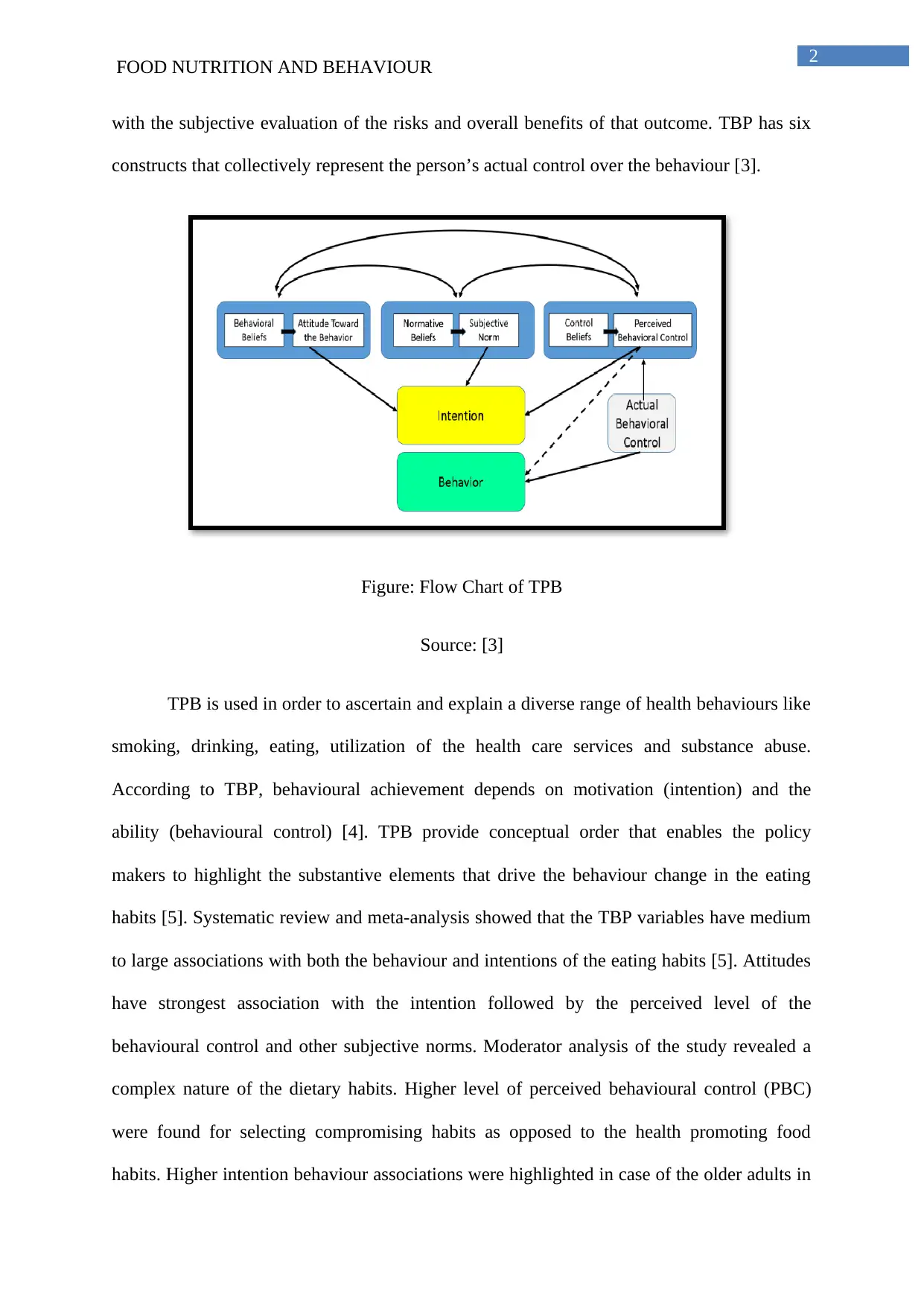
2
FOOD NUTRITION AND BEHAVIOUR
with the subjective evaluation of the risks and overall benefits of that outcome. TBP has six
constructs that collectively represent the person’s actual control over the behaviour [3].
Figure: Flow Chart of TPB
Source: [3]
TPB is used in order to ascertain and explain a diverse range of health behaviours like
smoking, drinking, eating, utilization of the health care services and substance abuse.
According to TBP, behavioural achievement depends on motivation (intention) and the
ability (behavioural control) [4]. TPB provide conceptual order that enables the policy
makers to highlight the substantive elements that drive the behaviour change in the eating
habits [5]. Systematic review and meta-analysis showed that the TBP variables have medium
to large associations with both the behaviour and intentions of the eating habits [5]. Attitudes
have strongest association with the intention followed by the perceived level of the
behavioural control and other subjective norms. Moderator analysis of the study revealed a
complex nature of the dietary habits. Higher level of perceived behavioural control (PBC)
were found for selecting compromising habits as opposed to the health promoting food
habits. Higher intention behaviour associations were highlighted in case of the older adults in
FOOD NUTRITION AND BEHAVIOUR
with the subjective evaluation of the risks and overall benefits of that outcome. TBP has six
constructs that collectively represent the person’s actual control over the behaviour [3].
Figure: Flow Chart of TPB
Source: [3]
TPB is used in order to ascertain and explain a diverse range of health behaviours like
smoking, drinking, eating, utilization of the health care services and substance abuse.
According to TBP, behavioural achievement depends on motivation (intention) and the
ability (behavioural control) [4]. TPB provide conceptual order that enables the policy
makers to highlight the substantive elements that drive the behaviour change in the eating
habits [5]. Systematic review and meta-analysis showed that the TBP variables have medium
to large associations with both the behaviour and intentions of the eating habits [5]. Attitudes
have strongest association with the intention followed by the perceived level of the
behavioural control and other subjective norms. Moderator analysis of the study revealed a
complex nature of the dietary habits. Higher level of perceived behavioural control (PBC)
were found for selecting compromising habits as opposed to the health promoting food
habits. Higher intention behaviour associations were highlighted in case of the older adults in
⊘ This is a preview!⊘
Do you want full access?
Subscribe today to unlock all pages.

Trusted by 1+ million students worldwide
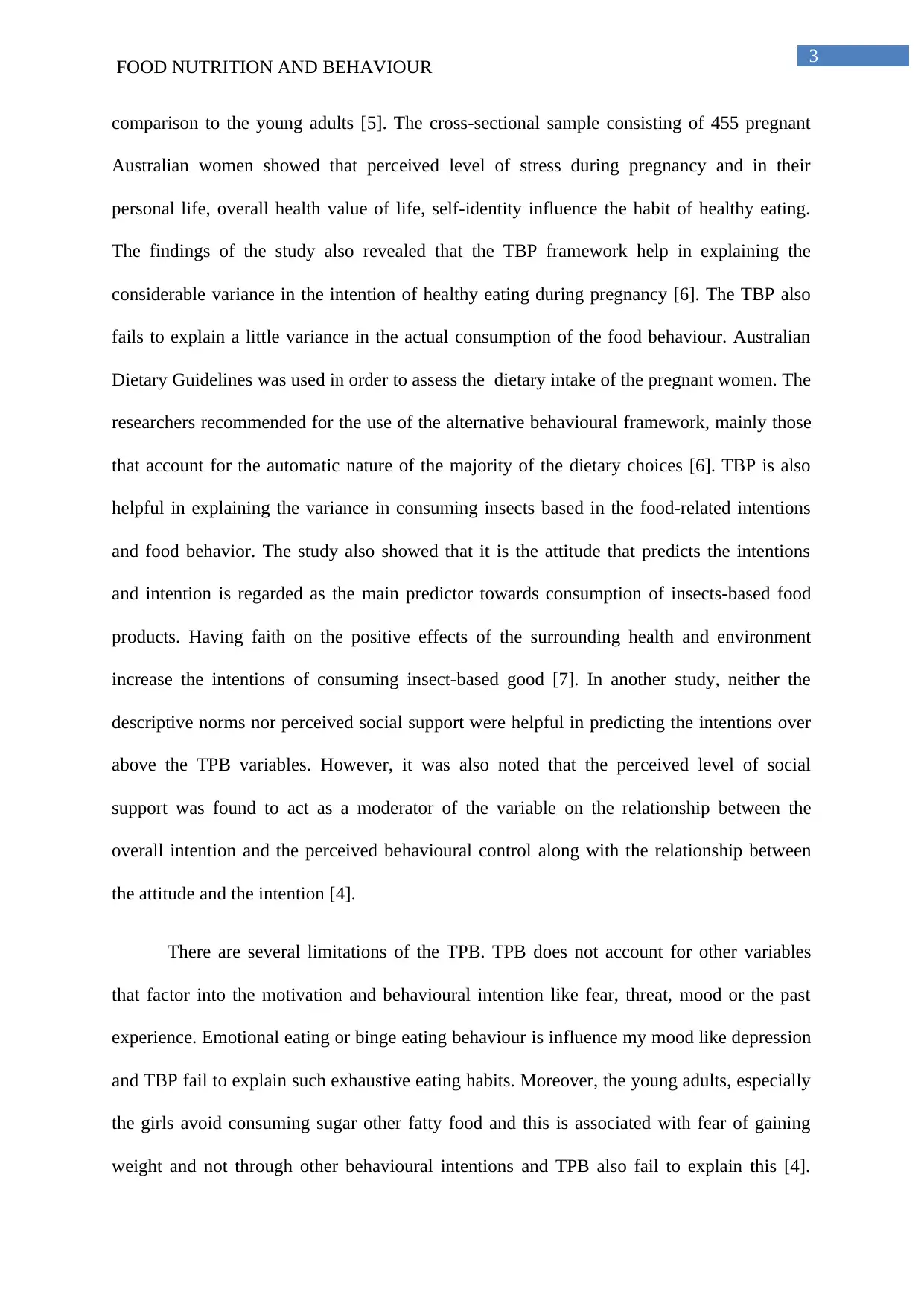
3
FOOD NUTRITION AND BEHAVIOUR
comparison to the young adults [5]. The cross-sectional sample consisting of 455 pregnant
Australian women showed that perceived level of stress during pregnancy and in their
personal life, overall health value of life, self-identity influence the habit of healthy eating.
The findings of the study also revealed that the TBP framework help in explaining the
considerable variance in the intention of healthy eating during pregnancy [6]. The TBP also
fails to explain a little variance in the actual consumption of the food behaviour. Australian
Dietary Guidelines was used in order to assess the dietary intake of the pregnant women. The
researchers recommended for the use of the alternative behavioural framework, mainly those
that account for the automatic nature of the majority of the dietary choices [6]. TBP is also
helpful in explaining the variance in consuming insects based in the food-related intentions
and food behavior. The study also showed that it is the attitude that predicts the intentions
and intention is regarded as the main predictor towards consumption of insects-based food
products. Having faith on the positive effects of the surrounding health and environment
increase the intentions of consuming insect-based good [7]. In another study, neither the
descriptive norms nor perceived social support were helpful in predicting the intentions over
above the TPB variables. However, it was also noted that the perceived level of social
support was found to act as a moderator of the variable on the relationship between the
overall intention and the perceived behavioural control along with the relationship between
the attitude and the intention [4].
There are several limitations of the TPB. TPB does not account for other variables
that factor into the motivation and behavioural intention like fear, threat, mood or the past
experience. Emotional eating or binge eating behaviour is influence my mood like depression
and TBP fail to explain such exhaustive eating habits. Moreover, the young adults, especially
the girls avoid consuming sugar other fatty food and this is associated with fear of gaining
weight and not through other behavioural intentions and TPB also fail to explain this [4].
FOOD NUTRITION AND BEHAVIOUR
comparison to the young adults [5]. The cross-sectional sample consisting of 455 pregnant
Australian women showed that perceived level of stress during pregnancy and in their
personal life, overall health value of life, self-identity influence the habit of healthy eating.
The findings of the study also revealed that the TBP framework help in explaining the
considerable variance in the intention of healthy eating during pregnancy [6]. The TBP also
fails to explain a little variance in the actual consumption of the food behaviour. Australian
Dietary Guidelines was used in order to assess the dietary intake of the pregnant women. The
researchers recommended for the use of the alternative behavioural framework, mainly those
that account for the automatic nature of the majority of the dietary choices [6]. TBP is also
helpful in explaining the variance in consuming insects based in the food-related intentions
and food behavior. The study also showed that it is the attitude that predicts the intentions
and intention is regarded as the main predictor towards consumption of insects-based food
products. Having faith on the positive effects of the surrounding health and environment
increase the intentions of consuming insect-based good [7]. In another study, neither the
descriptive norms nor perceived social support were helpful in predicting the intentions over
above the TPB variables. However, it was also noted that the perceived level of social
support was found to act as a moderator of the variable on the relationship between the
overall intention and the perceived behavioural control along with the relationship between
the attitude and the intention [4].
There are several limitations of the TPB. TPB does not account for other variables
that factor into the motivation and behavioural intention like fear, threat, mood or the past
experience. Emotional eating or binge eating behaviour is influence my mood like depression
and TBP fail to explain such exhaustive eating habits. Moreover, the young adults, especially
the girls avoid consuming sugar other fatty food and this is associated with fear of gaining
weight and not through other behavioural intentions and TPB also fail to explain this [4].
Paraphrase This Document
Need a fresh take? Get an instant paraphrase of this document with our AI Paraphraser
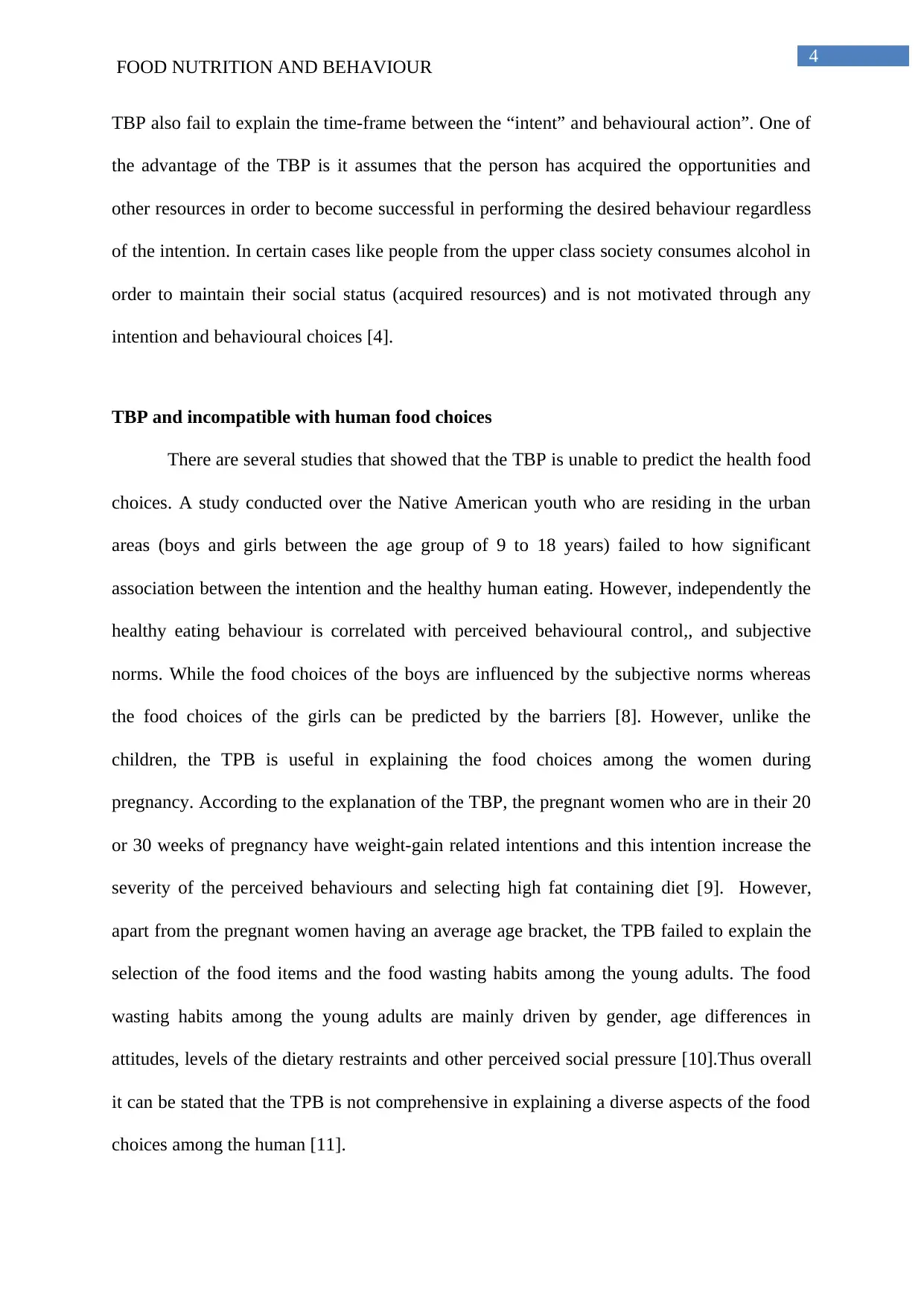
4
FOOD NUTRITION AND BEHAVIOUR
TBP also fail to explain the time-frame between the “intent” and behavioural action”. One of
the advantage of the TBP is it assumes that the person has acquired the opportunities and
other resources in order to become successful in performing the desired behaviour regardless
of the intention. In certain cases like people from the upper class society consumes alcohol in
order to maintain their social status (acquired resources) and is not motivated through any
intention and behavioural choices [4].
TBP and incompatible with human food choices
There are several studies that showed that the TBP is unable to predict the health food
choices. A study conducted over the Native American youth who are residing in the urban
areas (boys and girls between the age group of 9 to 18 years) failed to how significant
association between the intention and the healthy human eating. However, independently the
healthy eating behaviour is correlated with perceived behavioural control,, and subjective
norms. While the food choices of the boys are influenced by the subjective norms whereas
the food choices of the girls can be predicted by the barriers [8]. However, unlike the
children, the TPB is useful in explaining the food choices among the women during
pregnancy. According to the explanation of the TBP, the pregnant women who are in their 20
or 30 weeks of pregnancy have weight-gain related intentions and this intention increase the
severity of the perceived behaviours and selecting high fat containing diet [9]. However,
apart from the pregnant women having an average age bracket, the TPB failed to explain the
selection of the food items and the food wasting habits among the young adults. The food
wasting habits among the young adults are mainly driven by gender, age differences in
attitudes, levels of the dietary restraints and other perceived social pressure [10].Thus overall
it can be stated that the TPB is not comprehensive in explaining a diverse aspects of the food
choices among the human [11].
FOOD NUTRITION AND BEHAVIOUR
TBP also fail to explain the time-frame between the “intent” and behavioural action”. One of
the advantage of the TBP is it assumes that the person has acquired the opportunities and
other resources in order to become successful in performing the desired behaviour regardless
of the intention. In certain cases like people from the upper class society consumes alcohol in
order to maintain their social status (acquired resources) and is not motivated through any
intention and behavioural choices [4].
TBP and incompatible with human food choices
There are several studies that showed that the TBP is unable to predict the health food
choices. A study conducted over the Native American youth who are residing in the urban
areas (boys and girls between the age group of 9 to 18 years) failed to how significant
association between the intention and the healthy human eating. However, independently the
healthy eating behaviour is correlated with perceived behavioural control,, and subjective
norms. While the food choices of the boys are influenced by the subjective norms whereas
the food choices of the girls can be predicted by the barriers [8]. However, unlike the
children, the TPB is useful in explaining the food choices among the women during
pregnancy. According to the explanation of the TBP, the pregnant women who are in their 20
or 30 weeks of pregnancy have weight-gain related intentions and this intention increase the
severity of the perceived behaviours and selecting high fat containing diet [9]. However,
apart from the pregnant women having an average age bracket, the TPB failed to explain the
selection of the food items and the food wasting habits among the young adults. The food
wasting habits among the young adults are mainly driven by gender, age differences in
attitudes, levels of the dietary restraints and other perceived social pressure [10].Thus overall
it can be stated that the TPB is not comprehensive in explaining a diverse aspects of the food
choices among the human [11].
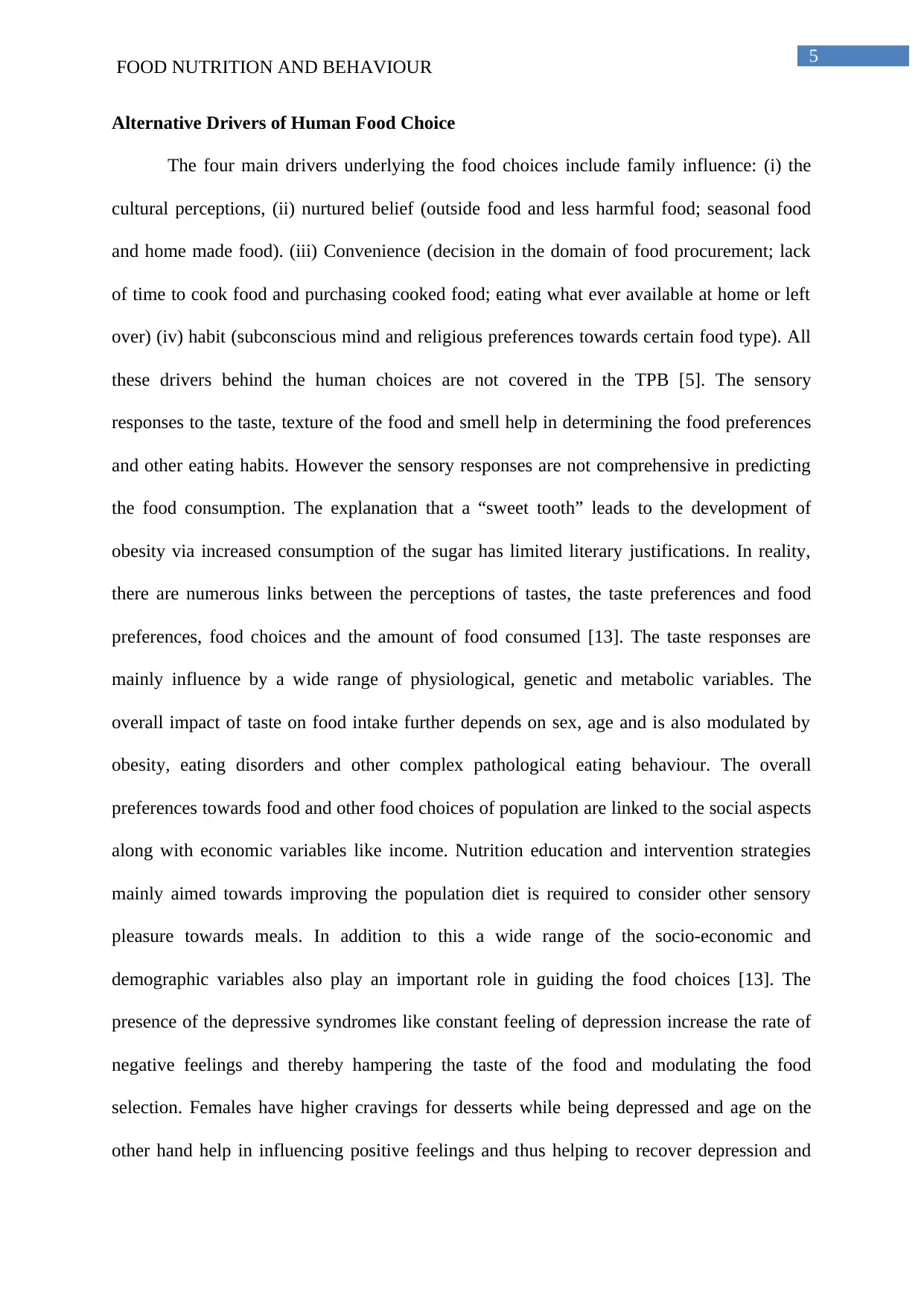
5
FOOD NUTRITION AND BEHAVIOUR
Alternative Drivers of Human Food Choice
The four main drivers underlying the food choices include family influence: (i) the
cultural perceptions, (ii) nurtured belief (outside food and less harmful food; seasonal food
and home made food). (iii) Convenience (decision in the domain of food procurement; lack
of time to cook food and purchasing cooked food; eating what ever available at home or left
over) (iv) habit (subconscious mind and religious preferences towards certain food type). All
these drivers behind the human choices are not covered in the TPB [5]. The sensory
responses to the taste, texture of the food and smell help in determining the food preferences
and other eating habits. However the sensory responses are not comprehensive in predicting
the food consumption. The explanation that a “sweet tooth” leads to the development of
obesity via increased consumption of the sugar has limited literary justifications. In reality,
there are numerous links between the perceptions of tastes, the taste preferences and food
preferences, food choices and the amount of food consumed [13]. The taste responses are
mainly influence by a wide range of physiological, genetic and metabolic variables. The
overall impact of taste on food intake further depends on sex, age and is also modulated by
obesity, eating disorders and other complex pathological eating behaviour. The overall
preferences towards food and other food choices of population are linked to the social aspects
along with economic variables like income. Nutrition education and intervention strategies
mainly aimed towards improving the population diet is required to consider other sensory
pleasure towards meals. In addition to this a wide range of the socio-economic and
demographic variables also play an important role in guiding the food choices [13]. The
presence of the depressive syndromes like constant feeling of depression increase the rate of
negative feelings and thereby hampering the taste of the food and modulating the food
selection. Females have higher cravings for desserts while being depressed and age on the
other hand help in influencing positive feelings and thus helping to recover depression and
FOOD NUTRITION AND BEHAVIOUR
Alternative Drivers of Human Food Choice
The four main drivers underlying the food choices include family influence: (i) the
cultural perceptions, (ii) nurtured belief (outside food and less harmful food; seasonal food
and home made food). (iii) Convenience (decision in the domain of food procurement; lack
of time to cook food and purchasing cooked food; eating what ever available at home or left
over) (iv) habit (subconscious mind and religious preferences towards certain food type). All
these drivers behind the human choices are not covered in the TPB [5]. The sensory
responses to the taste, texture of the food and smell help in determining the food preferences
and other eating habits. However the sensory responses are not comprehensive in predicting
the food consumption. The explanation that a “sweet tooth” leads to the development of
obesity via increased consumption of the sugar has limited literary justifications. In reality,
there are numerous links between the perceptions of tastes, the taste preferences and food
preferences, food choices and the amount of food consumed [13]. The taste responses are
mainly influence by a wide range of physiological, genetic and metabolic variables. The
overall impact of taste on food intake further depends on sex, age and is also modulated by
obesity, eating disorders and other complex pathological eating behaviour. The overall
preferences towards food and other food choices of population are linked to the social aspects
along with economic variables like income. Nutrition education and intervention strategies
mainly aimed towards improving the population diet is required to consider other sensory
pleasure towards meals. In addition to this a wide range of the socio-economic and
demographic variables also play an important role in guiding the food choices [13]. The
presence of the depressive syndromes like constant feeling of depression increase the rate of
negative feelings and thereby hampering the taste of the food and modulating the food
selection. Females have higher cravings for desserts while being depressed and age on the
other hand help in influencing positive feelings and thus helping to recover depression and
⊘ This is a preview!⊘
Do you want full access?
Subscribe today to unlock all pages.

Trusted by 1+ million students worldwide
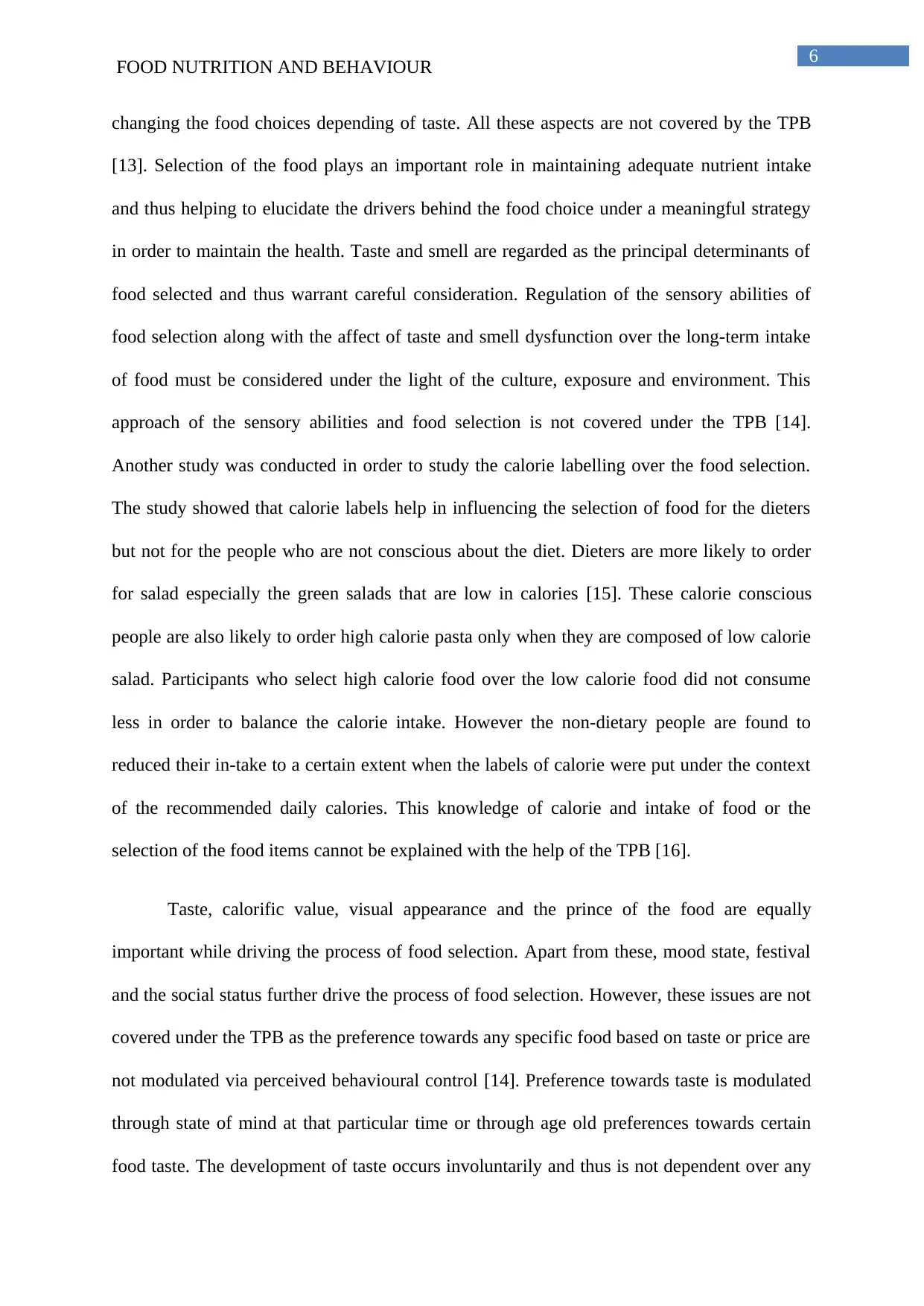
6
FOOD NUTRITION AND BEHAVIOUR
changing the food choices depending of taste. All these aspects are not covered by the TPB
[13]. Selection of the food plays an important role in maintaining adequate nutrient intake
and thus helping to elucidate the drivers behind the food choice under a meaningful strategy
in order to maintain the health. Taste and smell are regarded as the principal determinants of
food selected and thus warrant careful consideration. Regulation of the sensory abilities of
food selection along with the affect of taste and smell dysfunction over the long-term intake
of food must be considered under the light of the culture, exposure and environment. This
approach of the sensory abilities and food selection is not covered under the TPB [14].
Another study was conducted in order to study the calorie labelling over the food selection.
The study showed that calorie labels help in influencing the selection of food for the dieters
but not for the people who are not conscious about the diet. Dieters are more likely to order
for salad especially the green salads that are low in calories [15]. These calorie conscious
people are also likely to order high calorie pasta only when they are composed of low calorie
salad. Participants who select high calorie food over the low calorie food did not consume
less in order to balance the calorie intake. However the non-dietary people are found to
reduced their in-take to a certain extent when the labels of calorie were put under the context
of the recommended daily calories. This knowledge of calorie and intake of food or the
selection of the food items cannot be explained with the help of the TPB [16].
Taste, calorific value, visual appearance and the prince of the food are equally
important while driving the process of food selection. Apart from these, mood state, festival
and the social status further drive the process of food selection. However, these issues are not
covered under the TPB as the preference towards any specific food based on taste or price are
not modulated via perceived behavioural control [14]. Preference towards taste is modulated
through state of mind at that particular time or through age old preferences towards certain
food taste. The development of taste occurs involuntarily and thus is not dependent over any
FOOD NUTRITION AND BEHAVIOUR
changing the food choices depending of taste. All these aspects are not covered by the TPB
[13]. Selection of the food plays an important role in maintaining adequate nutrient intake
and thus helping to elucidate the drivers behind the food choice under a meaningful strategy
in order to maintain the health. Taste and smell are regarded as the principal determinants of
food selected and thus warrant careful consideration. Regulation of the sensory abilities of
food selection along with the affect of taste and smell dysfunction over the long-term intake
of food must be considered under the light of the culture, exposure and environment. This
approach of the sensory abilities and food selection is not covered under the TPB [14].
Another study was conducted in order to study the calorie labelling over the food selection.
The study showed that calorie labels help in influencing the selection of food for the dieters
but not for the people who are not conscious about the diet. Dieters are more likely to order
for salad especially the green salads that are low in calories [15]. These calorie conscious
people are also likely to order high calorie pasta only when they are composed of low calorie
salad. Participants who select high calorie food over the low calorie food did not consume
less in order to balance the calorie intake. However the non-dietary people are found to
reduced their in-take to a certain extent when the labels of calorie were put under the context
of the recommended daily calories. This knowledge of calorie and intake of food or the
selection of the food items cannot be explained with the help of the TPB [16].
Taste, calorific value, visual appearance and the prince of the food are equally
important while driving the process of food selection. Apart from these, mood state, festival
and the social status further drive the process of food selection. However, these issues are not
covered under the TPB as the preference towards any specific food based on taste or price are
not modulated via perceived behavioural control [14]. Preference towards taste is modulated
through state of mind at that particular time or through age old preferences towards certain
food taste. The development of taste occurs involuntarily and thus is not dependent over any
Paraphrase This Document
Need a fresh take? Get an instant paraphrase of this document with our AI Paraphraser
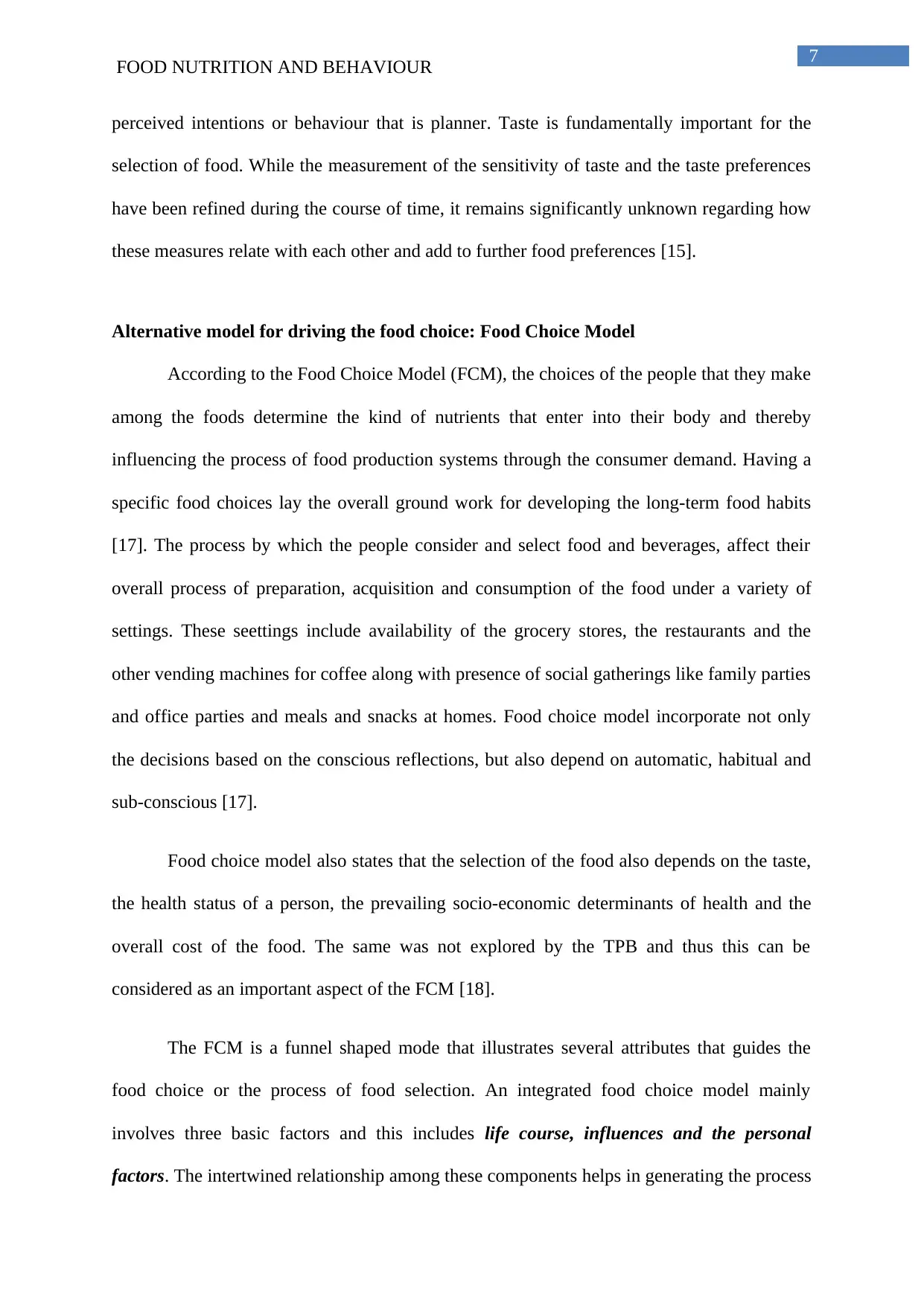
7
FOOD NUTRITION AND BEHAVIOUR
perceived intentions or behaviour that is planner. Taste is fundamentally important for the
selection of food. While the measurement of the sensitivity of taste and the taste preferences
have been refined during the course of time, it remains significantly unknown regarding how
these measures relate with each other and add to further food preferences [15].
Alternative model for driving the food choice: Food Choice Model
According to the Food Choice Model (FCM), the choices of the people that they make
among the foods determine the kind of nutrients that enter into their body and thereby
influencing the process of food production systems through the consumer demand. Having a
specific food choices lay the overall ground work for developing the long-term food habits
[17]. The process by which the people consider and select food and beverages, affect their
overall process of preparation, acquisition and consumption of the food under a variety of
settings. These seettings include availability of the grocery stores, the restaurants and the
other vending machines for coffee along with presence of social gatherings like family parties
and office parties and meals and snacks at homes. Food choice model incorporate not only
the decisions based on the conscious reflections, but also depend on automatic, habitual and
sub-conscious [17].
Food choice model also states that the selection of the food also depends on the taste,
the health status of a person, the prevailing socio-economic determinants of health and the
overall cost of the food. The same was not explored by the TPB and thus this can be
considered as an important aspect of the FCM [18].
The FCM is a funnel shaped mode that illustrates several attributes that guides the
food choice or the process of food selection. An integrated food choice model mainly
involves three basic factors and this includes life course, influences and the personal
factors. The intertwined relationship among these components helps in generating the process
FOOD NUTRITION AND BEHAVIOUR
perceived intentions or behaviour that is planner. Taste is fundamentally important for the
selection of food. While the measurement of the sensitivity of taste and the taste preferences
have been refined during the course of time, it remains significantly unknown regarding how
these measures relate with each other and add to further food preferences [15].
Alternative model for driving the food choice: Food Choice Model
According to the Food Choice Model (FCM), the choices of the people that they make
among the foods determine the kind of nutrients that enter into their body and thereby
influencing the process of food production systems through the consumer demand. Having a
specific food choices lay the overall ground work for developing the long-term food habits
[17]. The process by which the people consider and select food and beverages, affect their
overall process of preparation, acquisition and consumption of the food under a variety of
settings. These seettings include availability of the grocery stores, the restaurants and the
other vending machines for coffee along with presence of social gatherings like family parties
and office parties and meals and snacks at homes. Food choice model incorporate not only
the decisions based on the conscious reflections, but also depend on automatic, habitual and
sub-conscious [17].
Food choice model also states that the selection of the food also depends on the taste,
the health status of a person, the prevailing socio-economic determinants of health and the
overall cost of the food. The same was not explored by the TPB and thus this can be
considered as an important aspect of the FCM [18].
The FCM is a funnel shaped mode that illustrates several attributes that guides the
food choice or the process of food selection. An integrated food choice model mainly
involves three basic factors and this includes life course, influences and the personal
factors. The intertwined relationship among these components helps in generating the process
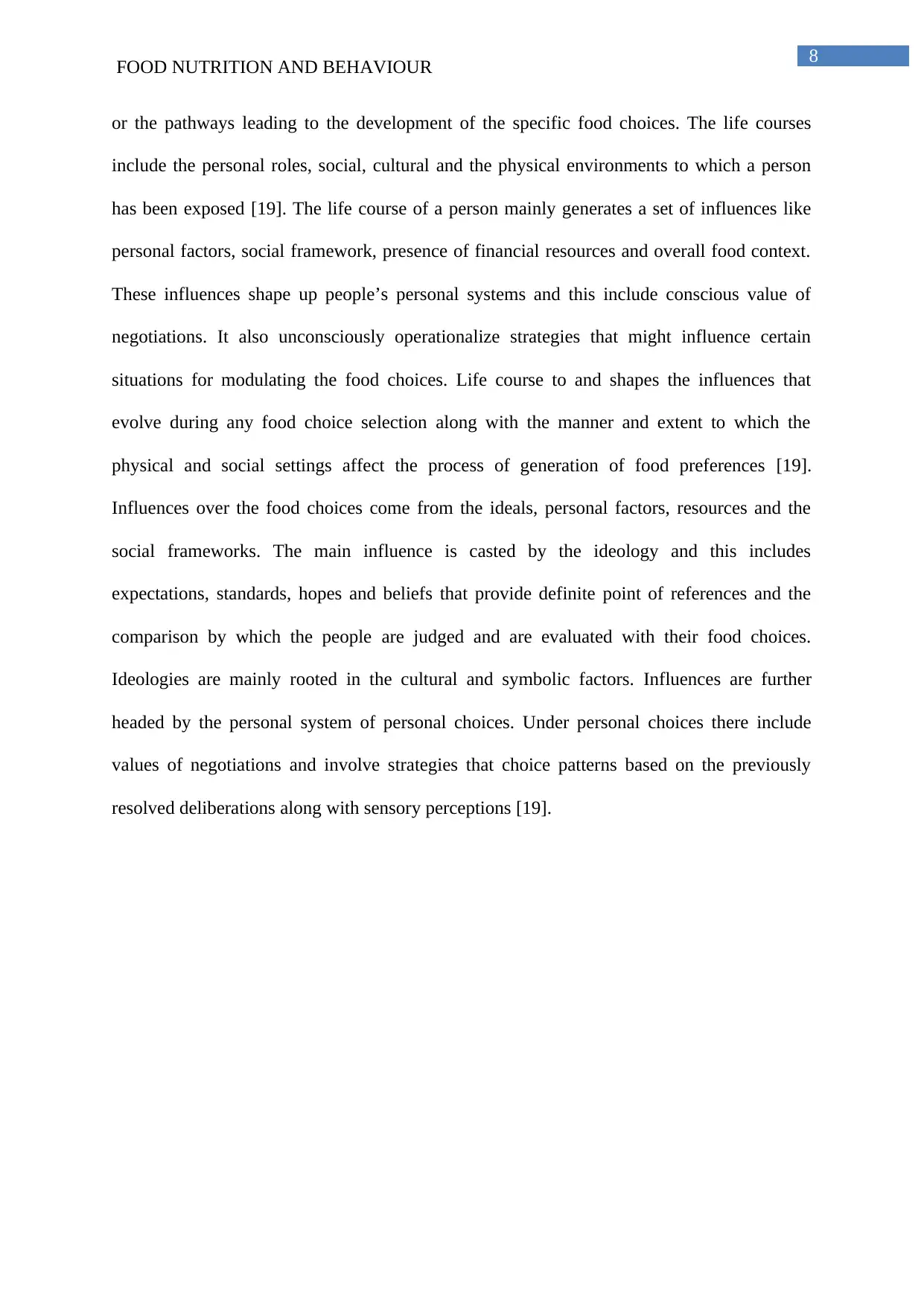
8
FOOD NUTRITION AND BEHAVIOUR
or the pathways leading to the development of the specific food choices. The life courses
include the personal roles, social, cultural and the physical environments to which a person
has been exposed [19]. The life course of a person mainly generates a set of influences like
personal factors, social framework, presence of financial resources and overall food context.
These influences shape up people’s personal systems and this include conscious value of
negotiations. It also unconsciously operationalize strategies that might influence certain
situations for modulating the food choices. Life course to and shapes the influences that
evolve during any food choice selection along with the manner and extent to which the
physical and social settings affect the process of generation of food preferences [19].
Influences over the food choices come from the ideals, personal factors, resources and the
social frameworks. The main influence is casted by the ideology and this includes
expectations, standards, hopes and beliefs that provide definite point of references and the
comparison by which the people are judged and are evaluated with their food choices.
Ideologies are mainly rooted in the cultural and symbolic factors. Influences are further
headed by the personal system of personal choices. Under personal choices there include
values of negotiations and involve strategies that choice patterns based on the previously
resolved deliberations along with sensory perceptions [19].
FOOD NUTRITION AND BEHAVIOUR
or the pathways leading to the development of the specific food choices. The life courses
include the personal roles, social, cultural and the physical environments to which a person
has been exposed [19]. The life course of a person mainly generates a set of influences like
personal factors, social framework, presence of financial resources and overall food context.
These influences shape up people’s personal systems and this include conscious value of
negotiations. It also unconsciously operationalize strategies that might influence certain
situations for modulating the food choices. Life course to and shapes the influences that
evolve during any food choice selection along with the manner and extent to which the
physical and social settings affect the process of generation of food preferences [19].
Influences over the food choices come from the ideals, personal factors, resources and the
social frameworks. The main influence is casted by the ideology and this includes
expectations, standards, hopes and beliefs that provide definite point of references and the
comparison by which the people are judged and are evaluated with their food choices.
Ideologies are mainly rooted in the cultural and symbolic factors. Influences are further
headed by the personal system of personal choices. Under personal choices there include
values of negotiations and involve strategies that choice patterns based on the previously
resolved deliberations along with sensory perceptions [19].
⊘ This is a preview!⊘
Do you want full access?
Subscribe today to unlock all pages.

Trusted by 1+ million students worldwide
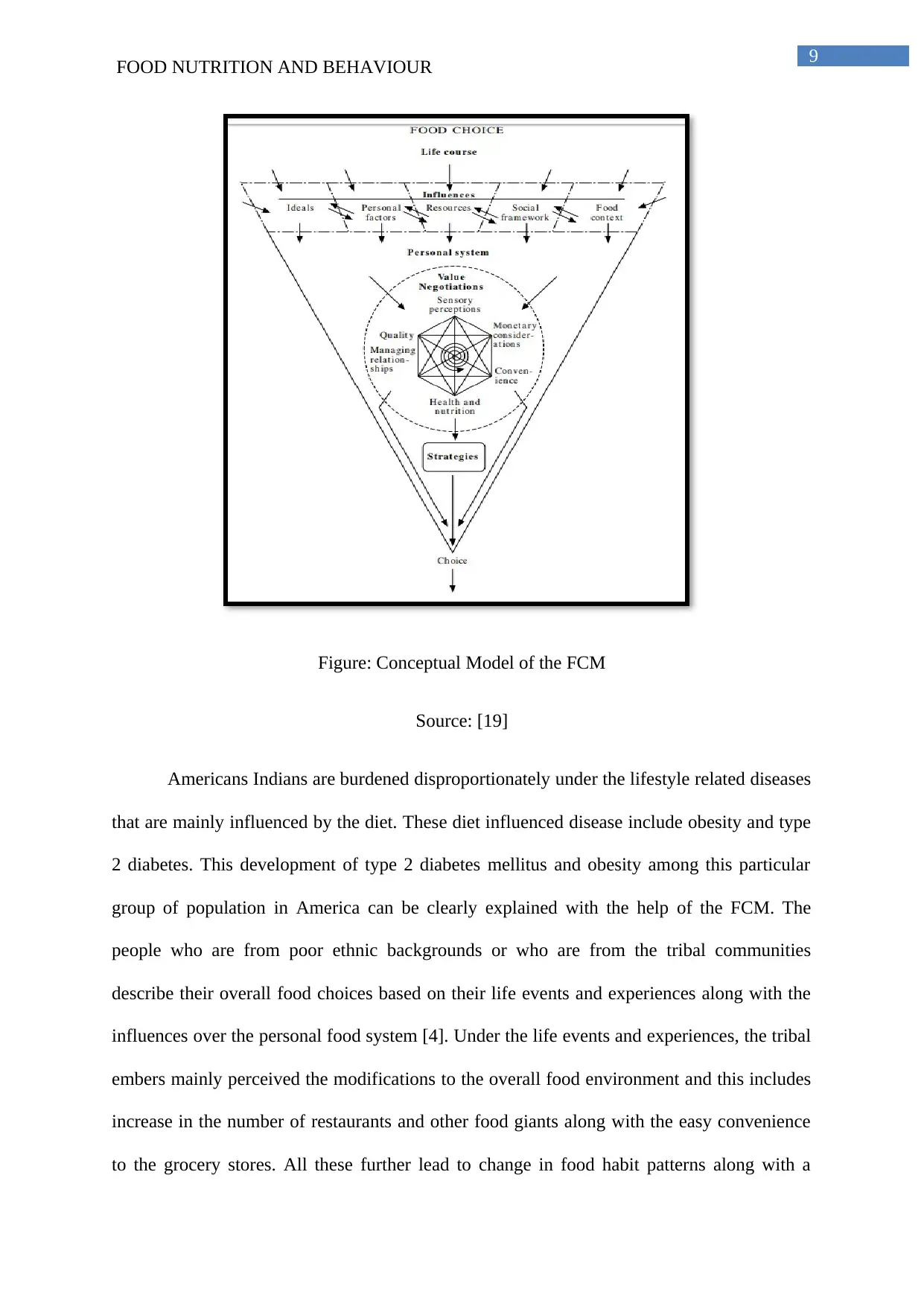
9
FOOD NUTRITION AND BEHAVIOUR
Figure: Conceptual Model of the FCM
Source: [19]
Americans Indians are burdened disproportionately under the lifestyle related diseases
that are mainly influenced by the diet. These diet influenced disease include obesity and type
2 diabetes. This development of type 2 diabetes mellitus and obesity among this particular
group of population in America can be clearly explained with the help of the FCM. The
people who are from poor ethnic backgrounds or who are from the tribal communities
describe their overall food choices based on their life events and experiences along with the
influences over the personal food system [4]. Under the life events and experiences, the tribal
embers mainly perceived the modifications to the overall food environment and this includes
increase in the number of restaurants and other food giants along with the easy convenience
to the grocery stores. All these further lead to change in food habit patterns along with a
FOOD NUTRITION AND BEHAVIOUR
Figure: Conceptual Model of the FCM
Source: [19]
Americans Indians are burdened disproportionately under the lifestyle related diseases
that are mainly influenced by the diet. These diet influenced disease include obesity and type
2 diabetes. This development of type 2 diabetes mellitus and obesity among this particular
group of population in America can be clearly explained with the help of the FCM. The
people who are from poor ethnic backgrounds or who are from the tribal communities
describe their overall food choices based on their life events and experiences along with the
influences over the personal food system [4]. Under the life events and experiences, the tribal
embers mainly perceived the modifications to the overall food environment and this includes
increase in the number of restaurants and other food giants along with the easy convenience
to the grocery stores. All these further lead to change in food habit patterns along with a
Paraphrase This Document
Need a fresh take? Get an instant paraphrase of this document with our AI Paraphraser
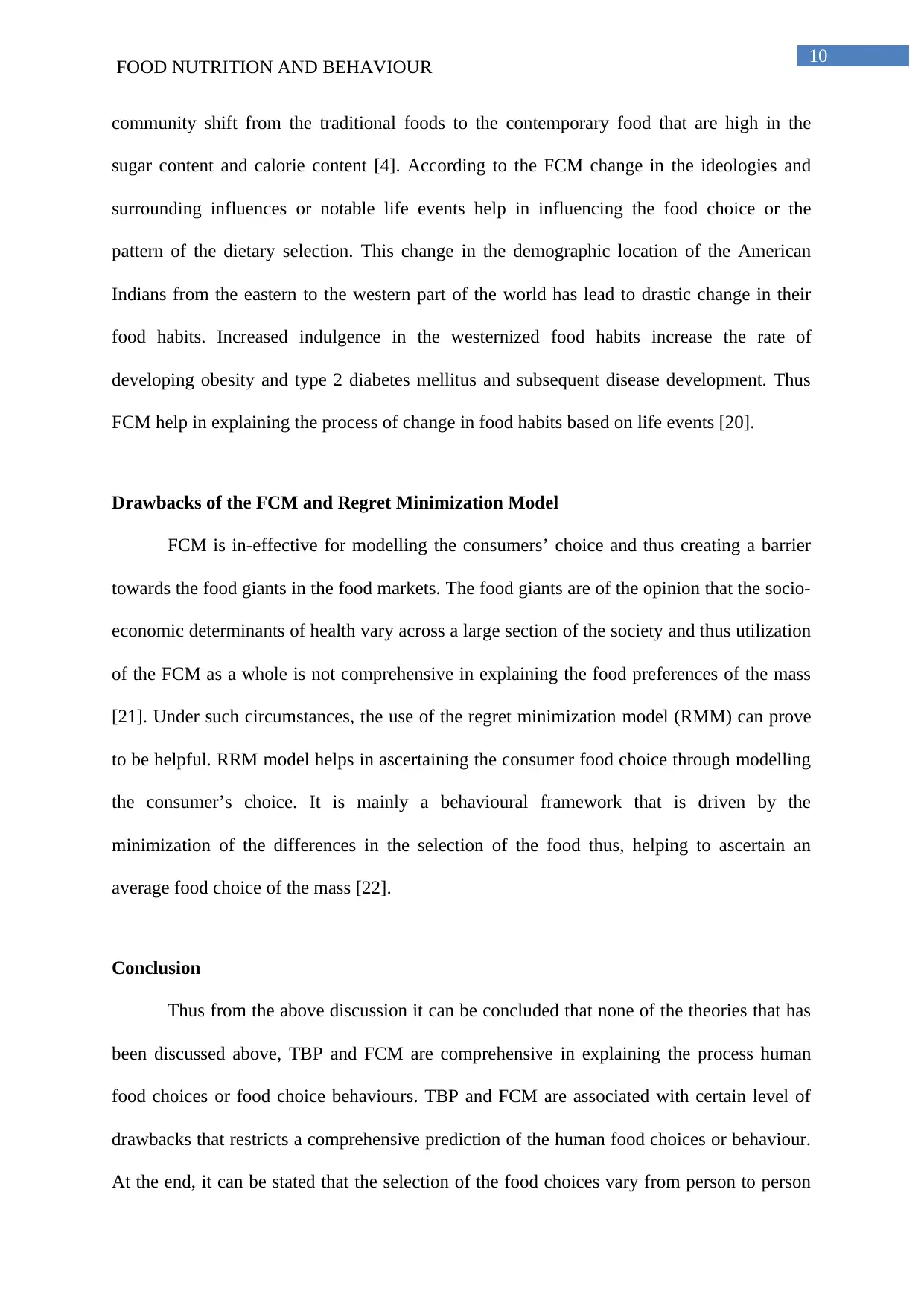
10
FOOD NUTRITION AND BEHAVIOUR
community shift from the traditional foods to the contemporary food that are high in the
sugar content and calorie content [4]. According to the FCM change in the ideologies and
surrounding influences or notable life events help in influencing the food choice or the
pattern of the dietary selection. This change in the demographic location of the American
Indians from the eastern to the western part of the world has lead to drastic change in their
food habits. Increased indulgence in the westernized food habits increase the rate of
developing obesity and type 2 diabetes mellitus and subsequent disease development. Thus
FCM help in explaining the process of change in food habits based on life events [20].
Drawbacks of the FCM and Regret Minimization Model
FCM is in-effective for modelling the consumers’ choice and thus creating a barrier
towards the food giants in the food markets. The food giants are of the opinion that the socio-
economic determinants of health vary across a large section of the society and thus utilization
of the FCM as a whole is not comprehensive in explaining the food preferences of the mass
[21]. Under such circumstances, the use of the regret minimization model (RMM) can prove
to be helpful. RRM model helps in ascertaining the consumer food choice through modelling
the consumer’s choice. It is mainly a behavioural framework that is driven by the
minimization of the differences in the selection of the food thus, helping to ascertain an
average food choice of the mass [22].
Conclusion
Thus from the above discussion it can be concluded that none of the theories that has
been discussed above, TBP and FCM are comprehensive in explaining the process human
food choices or food choice behaviours. TBP and FCM are associated with certain level of
drawbacks that restricts a comprehensive prediction of the human food choices or behaviour.
At the end, it can be stated that the selection of the food choices vary from person to person
FOOD NUTRITION AND BEHAVIOUR
community shift from the traditional foods to the contemporary food that are high in the
sugar content and calorie content [4]. According to the FCM change in the ideologies and
surrounding influences or notable life events help in influencing the food choice or the
pattern of the dietary selection. This change in the demographic location of the American
Indians from the eastern to the western part of the world has lead to drastic change in their
food habits. Increased indulgence in the westernized food habits increase the rate of
developing obesity and type 2 diabetes mellitus and subsequent disease development. Thus
FCM help in explaining the process of change in food habits based on life events [20].
Drawbacks of the FCM and Regret Minimization Model
FCM is in-effective for modelling the consumers’ choice and thus creating a barrier
towards the food giants in the food markets. The food giants are of the opinion that the socio-
economic determinants of health vary across a large section of the society and thus utilization
of the FCM as a whole is not comprehensive in explaining the food preferences of the mass
[21]. Under such circumstances, the use of the regret minimization model (RMM) can prove
to be helpful. RRM model helps in ascertaining the consumer food choice through modelling
the consumer’s choice. It is mainly a behavioural framework that is driven by the
minimization of the differences in the selection of the food thus, helping to ascertain an
average food choice of the mass [22].
Conclusion
Thus from the above discussion it can be concluded that none of the theories that has
been discussed above, TBP and FCM are comprehensive in explaining the process human
food choices or food choice behaviours. TBP and FCM are associated with certain level of
drawbacks that restricts a comprehensive prediction of the human food choices or behaviour.
At the end, it can be stated that the selection of the food choices vary from person to person
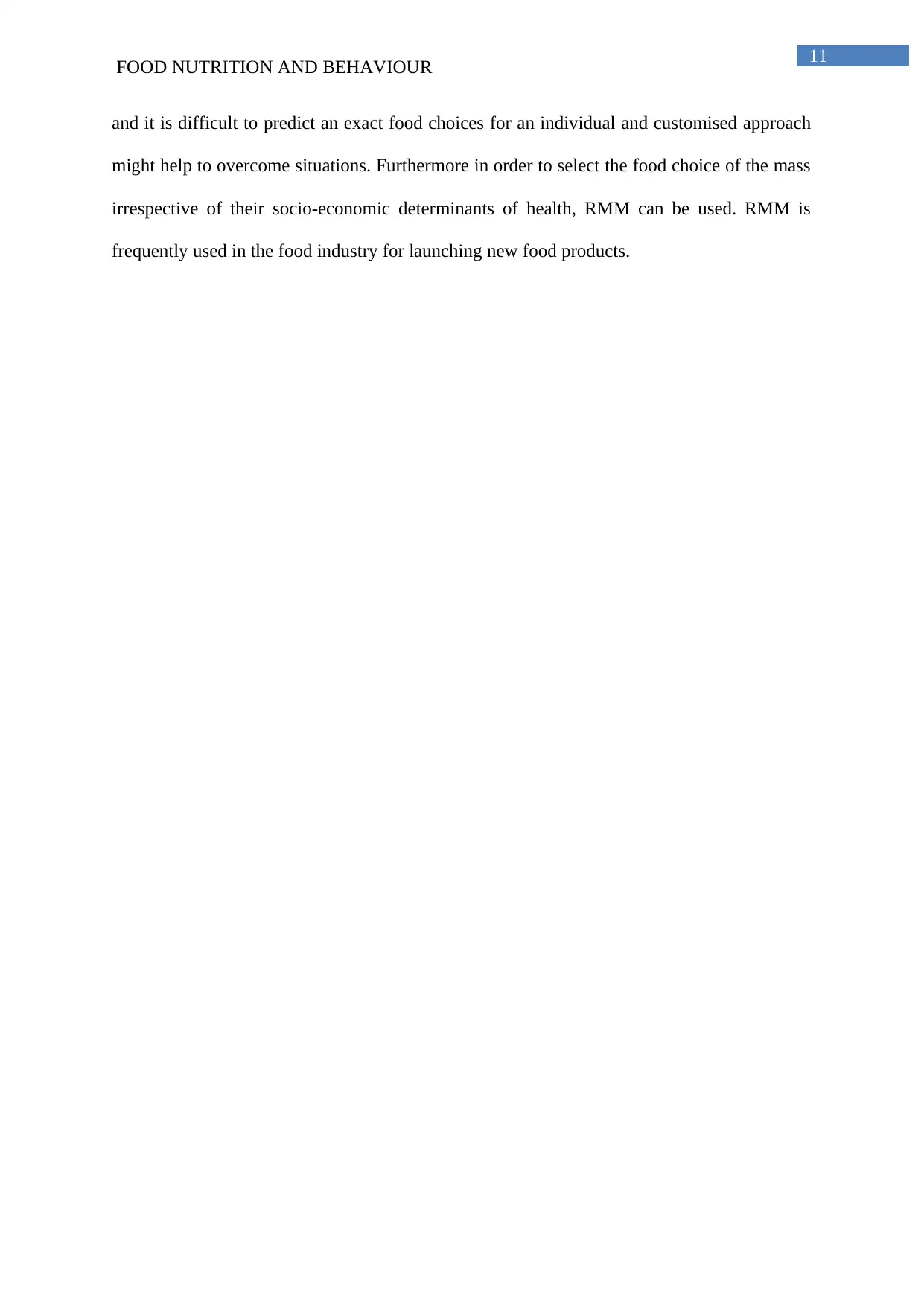
11
FOOD NUTRITION AND BEHAVIOUR
and it is difficult to predict an exact food choices for an individual and customised approach
might help to overcome situations. Furthermore in order to select the food choice of the mass
irrespective of their socio-economic determinants of health, RMM can be used. RMM is
frequently used in the food industry for launching new food products.
FOOD NUTRITION AND BEHAVIOUR
and it is difficult to predict an exact food choices for an individual and customised approach
might help to overcome situations. Furthermore in order to select the food choice of the mass
irrespective of their socio-economic determinants of health, RMM can be used. RMM is
frequently used in the food industry for launching new food products.
⊘ This is a preview!⊘
Do you want full access?
Subscribe today to unlock all pages.

Trusted by 1+ million students worldwide
1 out of 15
Related Documents
Your All-in-One AI-Powered Toolkit for Academic Success.
+13062052269
info@desklib.com
Available 24*7 on WhatsApp / Email
![[object Object]](/_next/static/media/star-bottom.7253800d.svg)
Unlock your academic potential
Copyright © 2020–2025 A2Z Services. All Rights Reserved. Developed and managed by ZUCOL.





